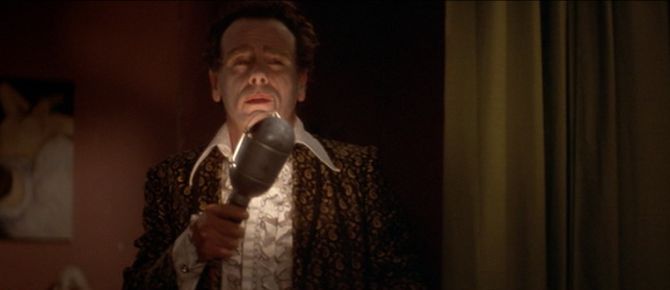 Back to selection
Back to selection
The Blue Velvet Project
Blue Velvet, 47 seconds at a time by Nicholas Rombes
The Blue Velvet Project, #101

Second #4747, 79:07
You, in one part of your brain, know that Ben is not really singing at this moment. But then, Roy Orbison is not singing, either. He is dead, although he was alive at the time of Blue Velvet (and credited the use of “In Dreams” in the film to helping revive his career). You know it’s lip-synched, and yet somehow it’s not. It can’t be. If this seems like a contradiction, then consider that the entire scene is a special case of black magic, culminating in Frank’s literal disappearance from the screen in a few minutes in a radical edit.
There is a stanza in Ben Lerner’s poem “Mean Free Path” (from the book of the same name) that goes like this:
Applause: Speak plainly. Keep your hands
On the table. Do not flee into procedure
Do not wait for a surpassing disaster
To look your brother in the eye and speak
Of love. Make no mistake: the disjunction
The disjunction stays. Do not hesitate
To cut the most beautiful line in the name
Of form. The bread of words. Look for me
At genre’s edge. I’m going there on foot
Those lines—“Do not hesitate / To cut the most beautiful line in the name / Of form”—may as well be the dark secret to Blue Velvet. There is something beautiful and terrifying and severe about Ben singing into the garage light, as his own, one-man garage band. From Ben’s voiceless throat, Orbison’s words become an incantation as frightening as anything real or imagined in Nathaniel Hawthorne’s story “Young Goodman Brown,” as Brown and his wife, at a witchs’ ritual in the night forest hesitate “on the verge of wickedness in this dark world.”
It becomes a moment so super-loaded with information that its binary code spills out of the screen.
There are not enough zeros and ones to express its meaning.
Over the period of one full year — three days per week — The Blue Velvet Project will seize a frame every 47 seconds of David Lynch’s classic to explore. These posts will run until second 7,200 in August 2012. For a complete archive of the project, click here. And here is the introduction to the project.
